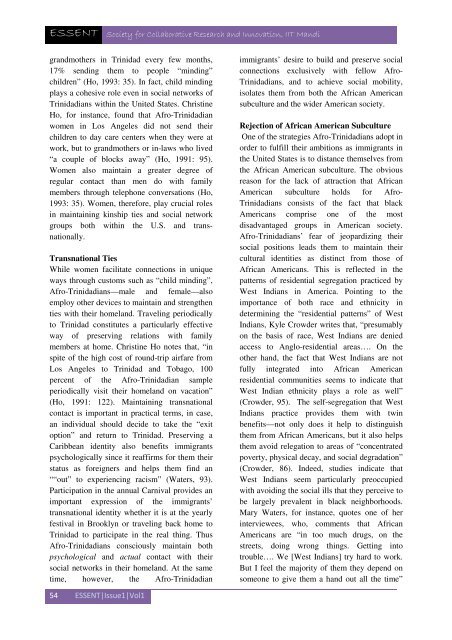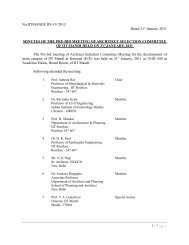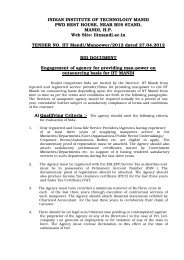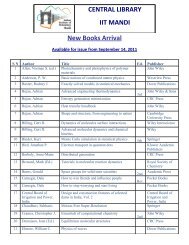Issue1. Vol.1 (April, 2013) - IIT Mandi
Issue1. Vol.1 (April, 2013) - IIT Mandi
Issue1. Vol.1 (April, 2013) - IIT Mandi
- No tags were found...
Create successful ePaper yourself
Turn your PDF publications into a flip-book with our unique Google optimized e-Paper software.
ESSENT Society for Collaborative Research and Innovation, <strong>IIT</strong> <strong>Mandi</strong>grandmothers in Trinidad every few months,17% sending them to people “minding”children” (Ho, 1993: 35). In fact, child mindingplays a cohesive role even in social networks ofTrinidadians within the United States. ChristineHo, for instance, found that Afro-Trinidadianwomen in Los Angeles did not send theirchildren to day care centers when they were atwork, but to grandmothers or in-laws who lived“a couple of blocks away” (Ho, 1991: 95).Women also maintain a greater degree ofregular contact than men do with familymembers through telephone conversations (Ho,1993: 35). Women, therefore, play crucial rolesin maintaining kinship ties and social networkgroups both within the U.S. and transnationally.Transnational TiesWhile women facilitate connections in uniqueways through customs such as “child minding”,Afro-Trinidadians—male and female—alsoemploy other devices to maintain and strengthenties with their homeland. Traveling periodicallyto Trinidad constitutes a particularly effectiveway of preserving relations with familymembers at home. Christine Ho notes that, “inspite of the high cost of round-trip airfare fromLos Angeles to Trinidad and Tobago, 100percent of the Afro-Trinidadian sampleperiodically visit their homeland on vacation”(Ho, 1991: 122). Maintaining transnationalcontact is important in practical terms, in case,an individual should decide to take the “exitoption” and return to Trinidad. Preserving aCaribbean identity also benefits immigrantspsychologically since it reaffirms for them theirstatus as foreigners and helps them find an““out” to experiencing racism” (Waters, 93).Participation in the annual Carnival provides animportant expression of the immigrants’transnational identity whether it is at the yearlyfestival in Brooklyn or traveling back home toTrinidad to participate in the real thing. ThusAfro-Trinidadians consciously maintain bothpsychological and actual contact with theirsocial networks in their homeland. At the sametime, however, the Afro-Trinidadianimmigrants’ desire to build and preserve socialconnections exclusively with fellow Afro-Trinidadians, and to achieve social mobility,isolates them from both the African Americansubculture and the wider American society.Rejection of African American SubcultureOne of the strategies Afro-Trinidadians adopt inorder to fulfill their ambitions as immigrants inthe United States is to distance themselves fromthe African American subculture. The obviousreason for the lack of attraction that AfricanAmerican subculture holds for Afro-Trinidadians consists of the fact that blackAmericans comprise one of the mostdisadvantaged groups in American society.Afro-Trinidadians’ fear of jeopardizing theirsocial positions leads them to maintain theircultural identities as distinct from those ofAfrican Americans. This is reflected in thepatterns of residential segregation practiced byWest Indians in America. Pointing to theimportance of both race and ethnicity indetermining the “residential patterns” of WestIndians, Kyle Crowder writes that, “presumablyon the basis of race, West Indians are deniedaccess to Anglo-residential areas…. On theother hand, the fact that West Indians are notfully integrated into African Americanresidential communities seems to indicate thatWest Indian ethnicity plays a role as well”(Crowder, 95). The self-segregation that WestIndians practice provides them with twinbenefits—not only does it help to distinguishthem from African Americans, but it also helpsthem avoid relegation to areas of “concentratedpoverty, physical decay, and social degradation”(Crowder, 86). Indeed, studies indicate thatWest Indians seem particularly preoccupiedwith avoiding the social ills that they perceive tobe largely prevalent in black neighborhoods.Mary Waters, for instance, quotes one of herinterviewees, who, comments that AfricanAmericans are “in too much drugs, on thestreets, doing wrong things. Getting intotrouble…. We [West Indians] try hard to work.But I feel the majority of them they depend onsomeone to give them a hand out all the time”54 ESSENT|Issue1|Vol1
















